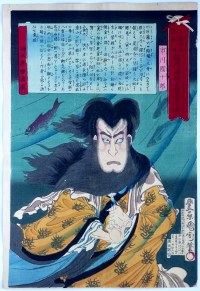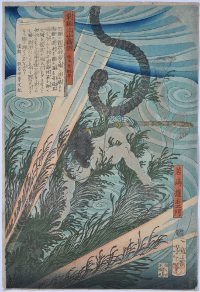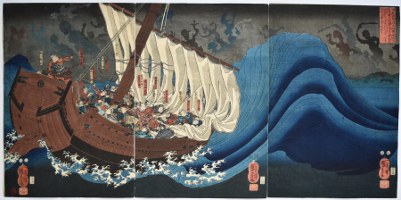/category/warriors-and-legends/page/8/
Tsukioka YOSHITOSHI (1839-1892)

Click here to view image full size.
A triptych from a set of ten: Dai Nippon shiryaku zue, “Short Illustrated History of Great Japan.” Each print is in the form of an unrolled makimono. This design shows the great battle of Dannoura in the Shimonoseki Strait off the southern tip of Honshu on April 25th, 1185. The engagement took place in the reign of the Emperor Antoku (who drowned in the battle, 1178-1185). The protagonists were the Minamoto clan (Genji) led by Minamoto no Yoshitsune and the Taira clan (Heike). The episode shown here is where Yoshitsune escapes the Heike general Noto no kami Noritsune by making the eight-boat leap. Published by Morimoto 1880.
Fine impression of first edition. Fine colour. Slight album backing, otherwise very good condition. Signed Taiso Yoshitoshi.
Status: Sold
Tsukioka YOSHITOSHI (1839-1892)

Click here to view image full size.
A triptych from a set Buyu setsugekka, “Heroes for the Snow, Moon and Flowers,” this being Gojo no tsuki, “Moon Over Gojo [Bridge].” Published by Isaya Kanekichi c 1867. A popular subject for artists it tells of the battle between the young Yoshitsune and the warrior monk Benkei who had secured the bridge and fought each samurai wanting to cross in order to steal their sword. The 1000th was Yoshitsune who defeats Benkei and secures his loyalty for the ensuing years. Yoshitsune was taught martial arts by tengu in the forests outside Kyoto as a child and they are seen here aiding and abetting him in his duel.
Fine impression, colour and condition. Full size with added mica at top. Signed Ikkaisai Yoshitoshi hitsu.
Status: Sold
Utagawa KUNIYOSHI (1797-1861)

Click here to view image full size.
A triptych of the night attack on Yoshitsune’s palace on the Hirikawa, Kyoto -hence called the Horikawa Palace – by the troops of Yoshitsune’s brother (Yoritomo) led by Tosaba Shoshun in 1185. Horikawa yo-uchi no zue. Yoshitsune is seen on the raised wooden platform with Benkei. Below is his mistress, Lady Shizuka, with a halberd. Yoshitsune’s brother’s mind was poisoned against him and he was thought of as a threat. Published by Sanoya Kihei, 1851.
Very good impression, colour and condition. Signed Ichiyusai Kuniyoshi ga.
Status: Sold
Utagawa KUNIYOSHI (1797-1861)

Click here to view image full size.
A triptych showing a figure in the centre painting Otsu-e pictures which float up and materialise as the actual characters. Toki ni Otsu-e kitai no maremono, “Popular Otsu-e Paintings for the Times: A long-awaited Rarity.” In fact, this is a self-portrait of Kuniyoshi. He is shown with one of his many cats watching him and his kiri seal fan to his left. Tantalizingly, Kuniyoshi partially covers his face with a painting. There are few images of Kuniyoshi. Published by Minatoya Kohei, c 1848.
Very good impression and colour. Slight crinckling of paper, otherwise very good condition. Signed ichiyusai Kuniyoshi ga.
Status: Sold
Toyohara KUNICHIKA (1835-1900)
Click here to view image full size.
Ichikawa Danjuro IX as the Chinese pirate from Fuzhou (Fukushu kaizoku) shichiso kanteirei from the set: Shiranui monogatari kanto no hitori. Shiranui monogatari was a picture-book published in three parts from 1849 onwards, written by three authors: Ryukatei Tanekazu, Ryutei Tanehiko II, and Ryusuitei Tanekiyo, with illustrations by Toyokuni III. In 1853 it became the subject of a popular Kabuki play. Published by Kobayashi Tetsujiro, 1879. A rare set.
Very fine impression, colour and condition with extensive burnishing. Signed Toyohara Kunichika ga.
Status: Sold
Toyohara KUNICHIKA (1835-1900)
Click here to view image full size.
Onoe Kikugoro V as Aoyagi Harunosuke Toshitada holding a large bronze bell from the set: Shiranui monogatari kanto no hitori. Shiranui monogatari was a picture-book published in three parts from 1849 onwards, written by three authors: Ryukatei Tanekazu, Ryutei Tanehiko II, and Ryusuitei Tanekiyo, with illustrations by Toyokuni III. In 1853 it became the subject of a popular Kabuki play. Published by Kobayashi Tetsujiro, 1879. A rare set.
Very fine impression, colour and condition. Signed Toyohara Kunichika ga.
Status: Sold
Utagawa KUNIYOSHI (1797-1861)
Click here to view image full size.
The warrior Kojoso Jisen in a tree by moonlight shining his lantern towards the ground. From the set Tsuzoku Suikoden goketsu hyaku-hachi-nin no hitori, “The Hundred and Eight Heroes of the Popular Suikoden, One by One.” Published by Kagaya Kichiyemon, 1827-30. Robinson S2. 33.
Fine impression and colour. Fine condition. Full size (unusual as this set are overlarge obans and often trimmed). Signed Ichiyusai Kuniyoshi ga.
Status: Sold
Utagawa KUNIYOSHI (1797-1861)
Click here to view image full size.
The warrior Hitentaisei Rikon in armour, holding a long-handled axe and scanning the horizon from a craggy outcrop. From the set Tsuzoku Suikoden goketsu hyaku-hachi-nin no hitori, “The Hundred and Eight Heroes of the Popular Suikoden, One by One.” Published by Kagaya Kichiyemon, 1827-30. Robinson S2. 21.
Extremely fine impression and colour. Fine condition. Full size (unusual as this set are overlarge obans and often trimmed). Signed Ichiyusai Kuniyoshi ga.
Status: Sold
Utagawa KUNIYOSHI (1797-1861)
Click here to view image full size.
The ronin Nakamura Kansuke Masatatsu dodging a brazier of hot ash. The best design from a fine set of twelve half length portraits of the forty-seven ronin: Seicho gishi shozo, “Portraits of Faithful Samurai of True Loyalty.” The depictions borrow strongly from western portraiture including imitation western script in the green border of the title cartouche. It is not necessary to repeat the story here as it is the best known Japanese tale. Published by Sumiyoshiya Masagoro, 12/1852.
Fine impression, colour and condition. Full size. The printing on this set is exceptional with details such as the sword blades and title cartouches burnished. Signed Kuniyoshi ga.
Status: Sold
Taiso YOSHITOSHI (1839-1892)
Click here to view image full size.
Wakashima Gonemon swimming underwater with a large rope attempting to retrieve the ancient dragon-headed bell of the Dragon God. The beams of light indicate its location. In the event, the rope broke and the bell is supposedly still in situ at the bottom of the Sumida river. The best design from Azuma no nishiki ukiyo kodan, “Tales of the Floating World on Eastern Brocade.” The stories retold by Kanagaki Robun (text at top). Published by Masudaya, 11/1867.
Very good impression, colour and condition. Full size. Signed Ikkaisai Yoshitoshi hitsu.
Status: Sold
Utagawa KUNIYOSHI (1797-1861)
Click here to view image full size.
A famous triptych: The ghosts of the Taira warriors attacking Yoshitsune’s ship in Daimotsu bay. Shows Minamoto no Yoshitsune (1159-89) aboard his ship Tsukimaru sailing along the coast of Settsu Province at Daimotsu. It was here that the Minamoto and Taira clans clashed and many Taira warriors perished. It is the ghosts of these that rise from the waves to attack Yoshitsune. His men struggle to lower the sail while Yoshitsune’s loyal retainer, Benkei, rubs his prayer beads and offers prayers to the gods of the sea and to Kannon, the Bodhisattva of mercy and the storm abates. Published 1849-51 by Enshuya Hikobei.
A very nice example of this rare print: A number of states exist, the earliest having white lines in the waves lower right. The main differences are with the ghosts. The horns and eyes are removed but the printing and gradation of these varies as well. This impression has the lines but the eyes and horns removed so seems to be an intermediate state between first and second editions. There is no great variation in impression between these states. Very good impression and colour. Slightly trimmed. otherwise very good condition. Signed Ichiyusai Kuniyoshi ga.
Status: Sold
Tsukioka YOSHITOSHI (1839-1892)
Click here to view image full size.
One of Yoshitoshi’s finest designs: Gikeiki Gojobashi no zu. The fight between Ushiwaka and Benkei on Gojo Bridge, Kyoto. The story relates how Benkei only needs one more blade to add to the 999 he has wrenched from samurai attempting to cross the bridge in order to fashion an invincible weapon. Benkei loses the fight and becomes Yoshitsune’s loyal retainer. Published 1881 by Morimoto Junzaburo.
Fine impression and colour. Very slight trimming, otherwise fine condition. Signed Taiso Yoshitoshi ga.
Status: Sold
Tsukioka YOSHITOSHI (1839-1892)
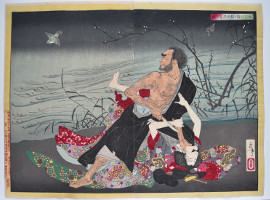
Click here to view image full size.
A diptych showing the Buddhist priest Dainin about to kill the girl Umegae. Daininbo Umegae o satsugai no zu, “Picture of the Priest Dainin Killing the Girl Umegae.” From a set of prints Shinsen azuma nishiki-e, “New Selection of Eastern Brocade Pictures.” The priest momentarily looks up at a passing cuckoo. The set published by Tsunashima Kamekichi between 1885 and 1889, this being 1886.
Very fine impression of the first edition. Fine colour and condition. Signed Yoshitoshi.
Status: Sold
Utagawa KUNIYOSHI (1797-1861)

Click here to view image full size.
A complete diptych showing Inukai Kempachi wielding an iron truncheon against Inudzuka Shino who stands, sword drawn, with one foot on a fallen follower of Kempachi during the fight on the Horyukaku roof of Koga Castle. A well-known episode from Kyokutei Bakin’s famous book, Nanso Satomi hakkenden, “The Chronicles of the Eight Dog Heroes of the Satomi Clan of Nanso.” From a set of prints Kendo ryaku den “Abridged Stories of Our Country’s Swordsmamship.” Published by Kadzusa-ya Iwazo, c. 1845-6. Robinson S37.6.5. The complete diptych is rare.
Very fine impression, colour and condition. Signed Ichiyusai Kuniyoshi ga.
Status: Sold
Okumura MASANOBU (1686-1764)

Click here to view image full size.
An hashira-e showing Shoki, the Chinese demon queller, Chung Kwei, about to plunge a sword into an oni. Another pillar print showing Shoki from the same period is illustrated in The Clarence Buckingham Collection of Japanese Prints, The Primitives, Helen C. Gunsaulus, AIC, 1955, no. 103, p. 166. Published c. 1745. Rare.
Very good impression. A sumi-e, printed in sumi with washes of sumi applied by hand. Slight toning, otherwise very good condition.Pillar prints are often toned because they were hung and, of course, this is especially true of the earlier examples, as here. Signed Hogetsudo
Tanchosai Okumura Bunkaku Masanobu Baio ga with seal Tanchosai.
Status: Sold
Kochoro KUNISADA (1786-1865)
Click here to view image full size.
An exceptionally rare triptych showing Minamoto no Yorimitsu (Raiko) and his loyal retainers, from left to right: Watanabe no Tsuna, Usui no Sadamitsu, Sakata no Kintoki and Urabe no Suetake killing the giant “Earth Spider.” Numerous versions exist of this story but basically Raiko and his followers have to tackle various horrendous apparitions in a cave within the hill Kagura ga oka near Kyoto, eventually to be faced by a beautiful woman who envelops Raiko in cobwebs. He slays her and her body turns into the spider, the head being twenty-five feet long and eyes shining like the sun and moon. He cuts off the beast’s head and the carcase reveals the many bodies devoured by it. An extremely early Kunisada print published by Nishimuraya Yohachi, c 1815. I have not seen this design before or located another impression.
Very good impression, colour and condition. Full size with extra paper around. Signed Kunisada ga.
Status: Sold
Toyohara CHIKANOBU (1838-1912)

Click here to view image full size.
Kusunoki Masatsura killing the magical tanuki from a set of 50 prints Azuma nishiki chuya kurabe, “Edo Embroidery Pictures.” The set published by Kobayashi Tetsujiro, 1886.
Fine impression, colour and condition. Signed Yoshu Chikanobu hitsu.
Status: Sold
Utagawa KUNIYOSHI (1797-1861)

Click here to view image full size.
A night scene illuminated by a band of light from a hand-lantern. Shows Ushiwaka-maru (Yoshitsune) battling with the outlaw priest Kumasada Chohan and his band of thieves who were attempting to rob the inn where Yoshitsune was staying. Published by Ibaya Sensaburo, c. 1839-41. A fine design.
Fine impression, colour and condition. Signed Ichiyusai Kuniyoshi ga.
Status: Sold
Tsukioka YOSHITOSHI (1839-1892)

Click here to view image full size.
A vertical triptych showing Taira no Kiyomori (1118-1181) watching Akugenta Yoshihira (“Wicked Genta of Kamakura”) (1140-1160) become the Thunder God and strike Namba no Jiro (1141-1160) down with a thunderbolt. An exceptional design of a subject that produced some excellent interpretations by Kuniyoshi and his pupils. Kiyomori nyudo Nunobiki no taki yuran Akugenta Yoshihira no rei Namba Jiro o utsu. The story originates from the Heiji Monogatari and relates how Minamoto no Yoshihira was defeated in the Heiji Rebellion of 1160 and decapitated by Namba no Saburo Tsunefusa, a retainer of Taira no Kiyomori. He pledges to return and kill Namba with a thunderbolt which he succeeds in doing in 1168 at the Nunobiki Waterfall. There is an alternative version of events that gives the decapitation and subsequent revenge killing as all taking place at the Nunobiki Waterfall. Published by Kinkyo (Omiya Kyujiro) in 1868. Of the utmost rarity: There might have been impressions circulating privately, but I have never seen an example for sale since I started dealing: Perhaps few impressions were printed, but the vertical triptych format is not conducive to it surviving intact. Another impression is in the MET, acc. no. 2007.49.307a-c. Possibly Yoshitoshi’s masterpiece.
Fine impression and colour. Some slight trimming. Oxidation and minor horizontal crease at bottom of centre sheet evident au verso, but otherwise in very good condition. Signed Tsukioka Yoshitoshi hitsu.
Status: Sold
Tsukioka YOSHITOSHI (1839-1892)

Click here to view image full size.
Shows Wakashima Gonemon diving into a whirlpool in an attempt to fasten a rope to the old dragon-headed temple bell and haul it up from the bed of the Sumida River. The story relates how the Dragon King thwarted his attempt by cutting the rope. From a set Azuma nishiki Ukiyo Kodan, “Rough Tales of the Floating World Told on Eastern Brocades.” Kodan (traditional storytelling) raconteurs narrated Japanese folk stories, sometimes accompanying themselves with wooden blocks clapped together or a fan giving rhythm. Having been popular from around 1700 (and known as Koshaku), these performances gained renewed popularity in the 1850s with the classic standards augmented by contemporary stories of heroes and vigilantes. Here, the storyteller Hogyusha Torin, narrates a story by Kanagaki Robun, the text seen in the open book top left. The best design from the set. Published by seven different publishers (here: Masudaya Ginjiro) between 1867-1868 (here: 1867).
Fine impression, colour and condition. Signed Ikkaisai Yoshitoshi hitsu.
Status: Sold
Utagawa SADAHIDE (1807-1873)

Click here to view image full size.
A snow scene: Act IX of the famous revenge drama, Kanadehon Chushingura, “The Treasury of Loyal Retainers.” Actually based on events of 1701-3. Shows Honzo appearing at Yuranosuke’s villa at Yamashina disguised as a komuso (a Japanese mendicant monk of the Fuke school of Zen Buddhism). Published by Kawaguchi-ya Uhei, c early 1840s.
Superb impression. Very fine colour and condition. Signed Sadahide ga.
Status: Sold
Tsukioka YOSHITOSHI (1839-1892)
Click here to view image full size.
The ronin Okuda Sadaemon Fujiwara Yukitaka ( number 42 ) from Seichu gishinden, “Tales of True Loyalty.” From a rare uncompleted set of the 47 Ronin published 6/1868 by Masudaya. Thirteen designs extant. It has been suggested that the set was completed but that the others are not known based on the fact that two of the prints are numbered 3 and 46. An error as artists did not commence and progress from number 1. Artists chose at random which numbers from a set to start with. Well known examples being Hiroshige’s Tokaido and Kisokaido.
Very good impression and colour. Light album backing. Signed Ikkaisai Yoshitoshi hitsu.
Status: Sold
Utagawa KUNIYOSHI (1797-1861)

Click here to view image full size.
“Goat” from a set Mitate junishi, “Selection for the Twelve Signs.” Shows the beauty Okoma looking through a curtain. Briefly the story relates how she is to be married off to a rich man by her mother but Okoma is in love with another man called Chushichi. A visiting barber cuts Chushichi’s hair and concocts a scheme with him to have her kidnaped and for Chushichi to rescue her. Published by Kojima c 1845. Robinson S38.8.
Fine impression, colour and condition. Signed Ichiyusai Kuniyoshi ga.
Status: Sold
Utagawa KUNIYOSHI (1797-1861)

Click here to view image full size.
“Hare” from a set Mitate junishi, “Selection for the Twelve Signs.” Shows Yama-uba with a rattle and a dancing white hare on Mount Ashigora. She is famous for bringing up Kintaro who played with the mountain animals. Published by Yenshuya Matabei, c 1845. Robinson S38.4.
Fine impression, colour and condition. Signed Ichiyusai Kuniyoshi ga.
Status: Sold
Utagawa KUNIYOSHI (1797-1861)
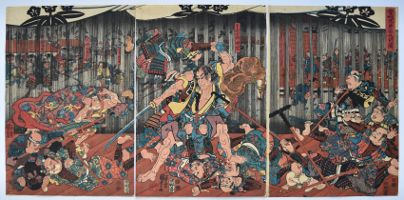
Click here to view image full size.
A triptych showing the night attack in pouring rain by the brothers Juro Soga and Goro Soga on their father’s murderer Kudo Suketsune. They had waited 18 years for the opportunity which came in 1193 when there was a hunting party held at the base of Mount Fuji by the Shogun Minamoto no Yoritomo. Soga kyodai chichi no ada-uchi no zu. In the centre is Goro and on the left Juro. Above, the cloth panels with the paulownia crest of the Minamoto clan. Published by Sanoya Kihei, 1851-3.
Fine impression and colour. Slight trimming at top and residual glue at edge of centre sheet, otherwise very good condition. Signed Ichiyusai Kuniyoshi ga.
Status: Available
Utagawa YOSHIIKU (1833-1904)

Click here to view image full size.
The warrior Torii Matasuke from a set Eimei nijuhasshuku, “Twenty Eight Famous Murders with Verse.” The set jointly designed by Yoshitoshi and Yoshiiku and depicts legendary and historical characters engaged in violent crimes. Matasuke is seen swimming in the Hime River gripping the topknot of a severed head between his teeth. Published by Kinseido, 1867.
Fine impression and colour. Lightly backed, otherwise very good condition. Signed Ikkeisai Yoshiiku ga.
Status: Sold
Utagawa KUNIYOSHI (1797-1861)

Click here to view image full size.
Oiwa and her ghost: Yondaime Ichikawa Kodanji IV no Oiwa bokon, “The Spirit of Oiwa Performed by Ichikawa Kodanji IV.” Probably in the play Atari mimasu yotsuya no kikigaki, performed at the Kawarasaki Theatre, 1848. The popular story has many versions, the gist being that Oiwa’s husband, Kamiya Lemon, falls in love with Oume, the daughter of a rich neighbour. Oume’s family poison Oiwa so that Lemon can marry the daughter. The poison hideously disfigures Oiwa who comes back to haunt Lemon. Published by Ebiya Rinnosuke, 1848.
Fine impression, colour and condition. Signed Ichiyusai Kuniyoshi ga.
Status: Sold
Utagawa KUNIYOSHI (1797-1861)

Click here to view image full size.
Saito Toshimoto nyudo Ryuhon (actually Saito Toshimitsu nyudo Ryuhon) in armour struggling with a Chinese brigand underwater. From the set Taiheiki yeiyuden, “Heroic Stories of the Taiheiki.” A history of the wars of the loyalist Nitta and Kusunoki families against the Ashikaga war-lords during the second quarter of the 14th century. But in fact the subject of this set of fifty prints (this numbered 48) is the civil war of the late 16th century. Censorship restrictions imposed in the 1840s prevented publishers from illustrating historical subjects from the Tensho era 1573-92 onwards, so the publishers circumvented this by slightly altering the names of the historical figures. Published 1848-9 by Yamamoto-ya Heikichi. There are a number of different states of this design, the preferable one, as here, has a light blue printed over the whole image to better depict the water. One of the best designs from the set.
Fine impression and colour. Slight centre fold and slight trimming at bottom. Light album backing. Signed Ichiyusai Kuniyoshi ga.
Status: Sold
Utagawa KUNIYOSHI (1797-1861)
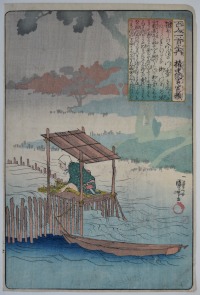
Click here to view image full size.
A poem by the celebrated poet Gonchunagon Sadayori from the series Hyakunin isshu no uchi, “One Hundred Poems for One Hundred Poets” which was compiled in 1235 by Fujiwara Teiki (1162-1241). Shows a fisherman catching fish in a fish trap. One of the best designs from the set with fine chiaroscuro printing of the background. Published by Ebisuya Shoshichi, Ebine, 1840-42. Only 58 of the 100 prints are known. Various translations of the poem exist, here is one:
In the early dawn
When the mists on Uji River
Slowly lift and clear
From the shallows to the deep
The stakes of fishing nets appear
Very fine impression. Fine colour. Slight nibbling of top right margin, otherwise very good condition. Signed Ichiyusai Kuniyoshi ga.
Status: Sold
Katsukawa SHUNTEI (1770-1820)

Click here to view image full size.
A diptych showing the warrior Nitta no Shiro Tadatsune (1167-1203) in the Hitoana Cave in Mt. Fuji brandishing a firebrand to illuminate the Sengen Bodhisattva, the Deity of Mount Fuji. He is sent on this mission by the Shogun Yoriie and discovers a pitch black cavern filled with bats and snakes. The Deity guides him through the Six Realms of Hell. Published by Yamamotoya Heikichi, c 1810s.
Very good impression, colour and condition. Signed Shuntei ga.
Status: Sold
Tsukioka YOSHITOSHI (1839-1892)

Click here to view image full size.
A triptych showing Saigo Takamori about to commit seppuku in a boat. Next to him are Murata Shinhachito and Kirino Yoshiaki. Saigo Takamori seppuku no zu. The “last true samurai,” he was instrumental in overthrowing the Tokugawa Shogunate. However, he had a falling out with the new Meiji government and returned to his native Satsuma in 1877 and led the so-called Satsuma Rebellion. This failed after seven months and the three in the boat were the last survivors of the rebellion. Published by Okura Magohei, 1877.
Very fine impression. Fine colour. Original album backing, otherwise good condition. Signed Oju Taiso Yoshitoshi.
Status: Sold
Utagawa YOSHITORA (Active c 1850-1880)

Click here to view image full size.
A triptych showing Sato Masakiyo, having invaded Shikoku and overthrowing the castle of Shosokabe Motochika, entered deep into the mountains where he battles an army of huge toads, lizards, bats, spiders, cats and dogs. Sato Masakiyo Shikoku seibatsu no toki Shosokabe Motochika no honjo o semeotosu ori kara hakarazu shinzan ni tachiiri kebutsu taiji no zu. Published by Kinseido, 1862.
Very good impression and colour. Album backing, otherwise good condition. Signed Yoshitora ga.
Status: Sold
Taiso YOSHITOSHI (1839-1892)
Click here to view image full size.
Uesugi Kenshin Nyudo Terutora riding into battle. From the fine set Yoshitoshi mushaburui, “Yoshitoshi’s Courageous Warriors.” Published by Kobayashi, 1883-1886 (this being 1883).
Fine impression and colour. Light toning, otherwise fine condition. This is the first edition. There are a number of later states and the set was republished by Tsunajima in 1886.
Status: Sold
Utagawa YOSHITSUYA (1822-1866)

Click here to view image full size.
The magician Ryuomaru battling with a giant dragon from a set of fine designs: Honcho musha kagami, “Mirror of Warriors of Our Country.” Published 1856-7 by Tsujiokaya Bunsuke. A good pupil of Kuniyoshi.
Good impression, colour and condition. Signed Ichieisai Yoshitsuya ga.
Status: Sold
Kawanabe KYOSAI (1831-1889)
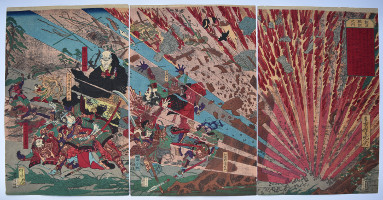
Click here to view image full size.
A triptych, Nanba senki no uchi, “The Battle of Nanba,” showing the Buddhist monk Tenkai (1536-1643) chanting a spell, and Okubo Hikozaemon (1560-1639), both retainers of Tokugawa Ieyasu, at the great battle of Domyoji, Osaka, in 1615. Tokugawa Ieyasu’s army clashed with the Osaka army of Toyotomi Hideyori. This led to the fall of Osaka and the death of Hideyori. On the right is a huge exploding land-mine disintegrating a Buddhist stone statue. Published by Ebisuya Shoshichi, 4/1874. Extremely rare: I have only seen one other impression of this design.
Fine impression and colour. Trimmed, otherwise very good condition. Signed Seisai Kyosai and Oju Seisai Kyosai.
Status: Sold
Ogata GEKKO (1859-1920)

Click here to view image full size.
A triptych showing the last stand of the Kusunoki Clan at the Battle of Shijonawate in 1348. The event took place during the Nanbokucho wars when the Kusunoki Masatsura forces of the Southern Imperial Court were attacked at Yoshino by the Northern forces led by Ko no Moroyasu. Masatsura fought valiantly against a hail of arrows, eventually succumbing and committing suicide. . Published 1883 by Matsuo Danzo (who only appears to have survived one year). There is an earlier triptych version of this by Gekko in 1878. A later and far inferior reprint was published in 1901.
Superb impression, colour and condition with extensive burnishing. Signed Gekko ga.
Status: Sold
Utagawa KUNIYOSHI (1797-1861)
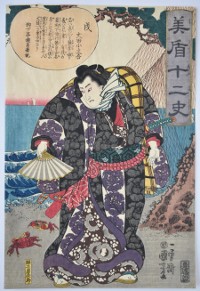
Click here to view image full size.
A print from the set Mitate junishi, “Selection for the Twelve Signs [of the Zodiac].” This being Dog. Shows the wrestler Inuda (Inu, “Dog”) Kobungo umpiring a match between two crabs. Published c. 1845 by Iba-ya Sensaburo. Robinson S38.11.
Fine impression and colour. Very slight trimming, otherwise fine condition. Signed Ichiyusai Kuniyoshi ga.
Status: Sold
Tsukioka YOSHITOSHI (1839-1892)
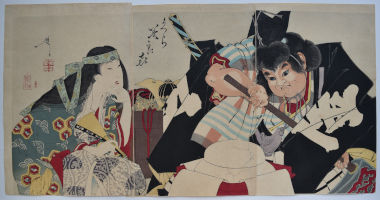
Click here to view image full size.
A triptych showing Yamauba on the left and Kintaro about to wield a large axe to break a large Kaga mimochi, mirror rice cake. This is a traditional Shinto rite in January. January 11th is also the day the wealthy opened their storehouses to air their precious possessions (Kurabiraki). Published by Akiyama Buemon 1891.
Very fine impression with extensive burnishing. Fine colour and condition. Signed Yoshitoshi.
Status: Sold
Utagawa KUNIYOSHI (1797-1861)

Click here to view image full size.
Oho ( Wang P’ou ) visiting his mother’s tomb to comfort her during a thunderstorm. Shows peasants fleeing the zigzag lightning bolts. From a set of fourteen prints: Nijushi-ko doji kagami, “Mirror of the Twenty-Four Paragons of Filial Piety.” Published by Wakasa-ya Yoichi, c 1840. Each print shows an example of a child’s exemplary behaviour in looking after their aged parents There is a strong western influence in this set. Robinson S13.14.
Very good impression and colour. Slight centre fold, otherwise good condition. Signed Ichiyusai Kuniyoshi ga.
Status: Sold
Tsukioka YOSHITOSHI (1839-1892)

Click here to view image full size.
Haso no tsuki, “Moon Through a Crumbling Window” from the set Tsuki hyakushi, the “Hundred Phases of the Moon.” The set published between 1885 and 1892 (this being 1886) by Akiyama Buemon. Shows Bodhidharma (Jap: Daruma), founder of Zen Buddhism, meditating in a cave for nine years after being refused entry to the Shaolin Monastery. He cut off his eyelids in anger after falling asleep two years into the meditation, and tea plants grew where they fell.
Fine impression with strong woodgrain showing in the sky and wall. The set was popular and many editions were printed and many late impressions exist. Great care was taken with the cutting of the blocks on this set and only early impressions do them justice. Fine colour and condition. An impression that has not been in an album. Full margins. Signed Yoshitoshi.
Status: Sold
